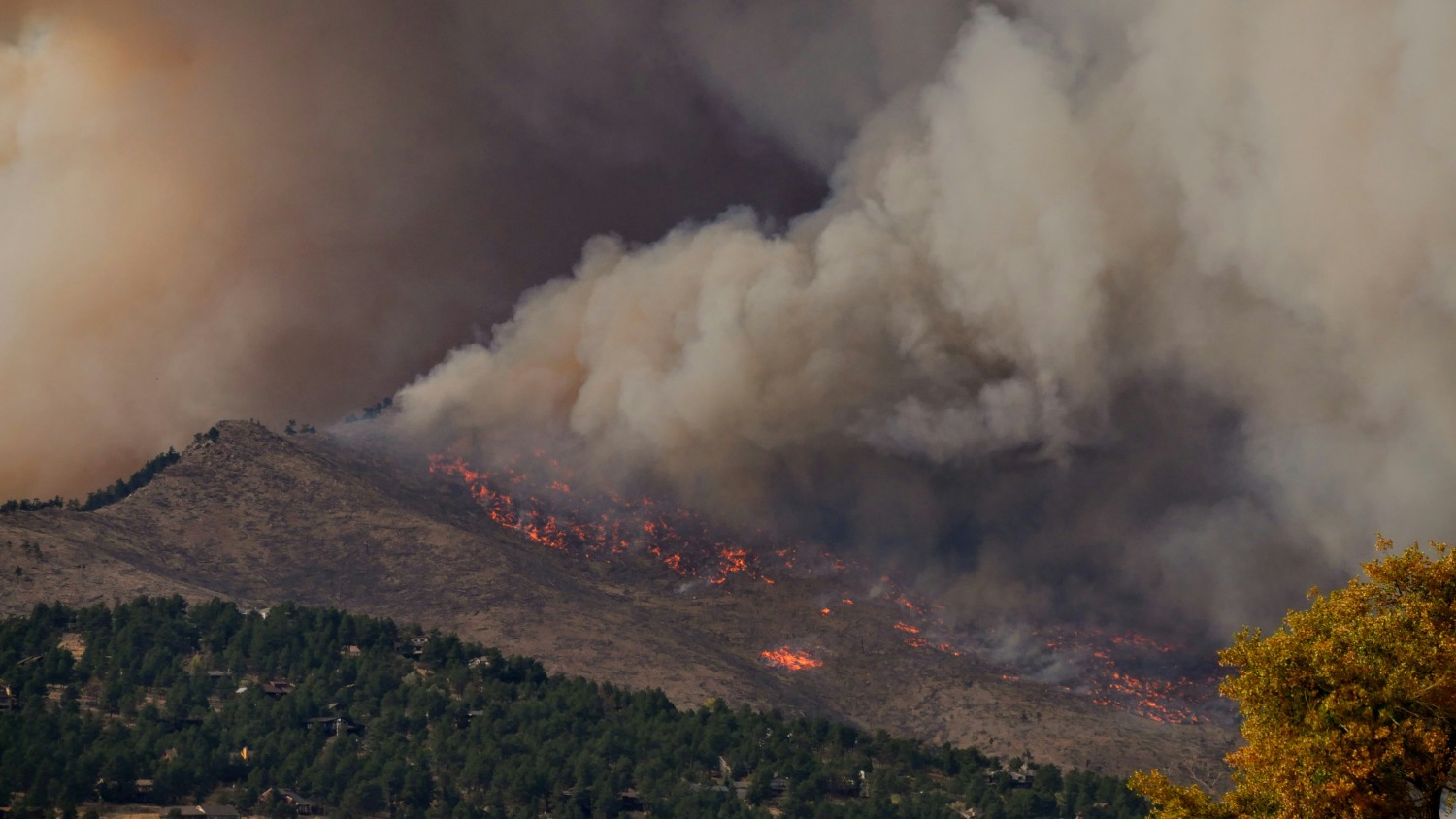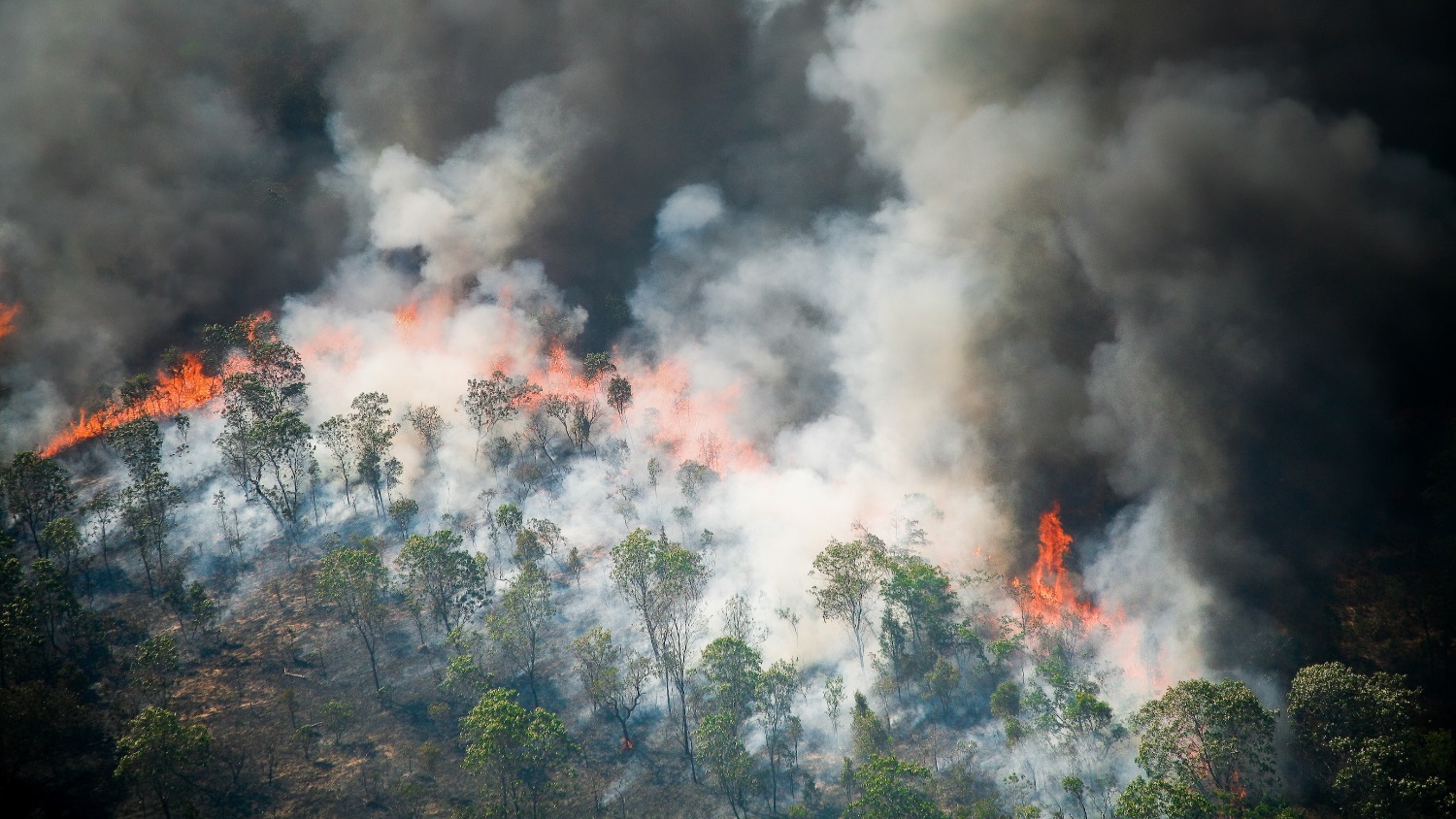Explainer: How Wildfires Start and Spread

Every year, thousands of wildfires burn across the United States. These fires not only scorch millions of acres of land but also result in human casualties and billions of dollars in damages to surrounding communities.
This year, the total number of fires is on a downward trend. But wildfires are burning more acreage than in previous years, according to the latest report from the National Interagency Fire Center.
A total of 52,729 wildfires have burned 6,631,430 acres across the lower 49 states so far this year, according to the agency’s data. That’s a 4% increase in the average number of acres burned from the previous 10 years.
In North Carolina, a wildfire at Pilot Mountain State Park recently scorched more than 1,000 acres. The blaze, which started as a campfire, took local and state agencies more than a week to extinguish. There were no injuries, deaths or damages to nearby structures.
We spoke with NC State professor Joseph Roise, who studies wildland fire behavior and prevention, to gain a better understanding of how wildfires like the one at Pilot Mountain State Park start and spread. Here’s what we found out.
How do wildfires start?
Wildfires can start from natural causes, such as lightning, but most are caused by humans. In fact, about 85% of wildfires in the U.S. result from human causes, including arson, unattended campfires and debris fires and discarded cigarettes.
“Human carelessness is the biggest contributing factor to the start of wildfires,” said Joseph Roise, a professor of forestry and environmental resources at NC State, whose research focuses on wildfire behavior and prevention.
No matter the cause, wildfires require three key components to ignite: fuel, heat and oxygen. These components are commonly referred to as the “fire triangle,” according to Roise.
Fire is the effect of a chemical reaction known as combustion, which occurs between oxygen in the air and some sort of fuel that’s been heated to its flash point, or the lowest temperature at which it will ignite.
Fuel is any kind of flammable material, including trees, grasses, shrubs, and even houses. These materials emit a vapor. Heat brings these fuels to their flash point, causing the vapor to evaporate and mix with oxygen.
Oxygen is the naturally occurring element needed for igniting and sustaining a fire. When burning fuel is exposed to oxygen from the air, a chemical reaction occurs that releases heat and generates combustion.
A fire can only occur when all three components react together, according to Roise. So in order for a fire to be extinguished, at least one of the components of the “fire triangle” must be removed.
Wildfires can happen any time of the year. But generally, the risk of wildfires increases when an area experiences increasingly dry and warm conditions, such as drought.
Drought conditions are sometimes preceded by a period of above average rainfall, which encourages more plants and trees to grow. This vegetation, however, usually wilts and becomes dried out when drought conditions occur, reducing moisture content and providing ample fuel for wildfires.
Roise said drought conditions — and wildfires — typically occur in North Carolina in the late fall or early winter, sometimes extending into the spring. In California, on the other hand, the risk of wildfires is highest between August and November when hot, dry winds are most frequent.
“The southeast doesn’t really experience wildfires during the summer, because the ground is so wet from all the rain,” Roise said. “You could dump several gallons of gasoline out in the woods and light it and nothing would happen. It’s a different story out west. They’ve had drought for years.”
Storms and other natural hazards can also raise the risk of wildfires. Hurricane-force winds, for example, can kill a large number of trees in pine forests, leaving behind a large amount of dead needles that can easily ignite when exposed to a heat source.
How do wildfires spread?
Wildfires can fizzle out quickly or spread uncontrolled, consuming thousands of acres of land in a matter of hours. But the intensity and movement of a wildfire ultimately depends on three factors: fuel, weather and topography. These factors are collectively known as the “fire behavior triangle.”
A fuel’s composition, including moisture level, chemical makeup and even density, influences how quickly a fire will spread and at what temperature. The moisture content of fuel, for example, determines how much of an area will burn. So if vegetation has a low moisture level and is very dry, a fire will burn faster and more intensely because the heat doesn’t have to eliminate water.
“Fire isn’t going to occur until the moisture content in the fuel reaches the point where there’s enough net energy coming from the heat source. Once the heat has evaporated enough water, the fuel will burn,” said Joseph Roise, a professor of forestry and environmental resources at NC State.
The size and amount of fuel also affects wildfire behavior, according to Roise, who studies wildfire behavior and prevention. Small fuel sources such as grasses typically burn quicker and don’t generate as much heat as trees and other large fuel sources, for example. And while a small amount of fuel will cause a fire to spread slowly with lower intensity, a lot of fuel will cause a fire to spread faster with more intensity.
Some plants, trees and shrubs also contain oils and resins that cause them to burn more quickly and intensely. Additionally, some types of vegetation naturally have less moisture content. Oak leaves, for example, tend to be drier because they curl and have more surface area available for drying, in comparison to other hardwood species. Because of the lower moisture content, they’re more flammable and capable of “carrying a fire,” Roise said.
Weather conditions such as wind, temperature and humidity also play a major role in the behavior of a wildfire. Wind, for example, supplies fire with additional oxygen. This can cause a fire to move across a landscape at a faster rate.
“If the wind is really strong, you can expect to see a wildfire that’s moving quickly,” Roise said. “There might even be some embers that spread and start fires in locations that are sometimes up to a quarter of a mile away from the original fire.”
High temperatures and low humidity also dry out fuel sources, causing them to ignite and burn faster. This is why wildfires typically become more intense and spread fastest in the afternoon, when the air is hottest.
“If humidity is very high, fire isn’t going to do much because the heat has to burn off moisture in the air to ignite the fuel,” Roise said.
Topographical features of a landscape, such as slope, elevation and aspect, can also facilitate wildfire progression. If a fire ignites at the bottom of a steep slope, for example, it will spread more quickly uphill because heat rises. As that hot air rises, it preheats fuels that are further uphill, causing them to readily ignite once the fire reaches them.
Elevation and aspect (direction of the slope) can determine the temperature and moisture level in fuels across a landscape, according to Roise. For example, fuel that’s on a south-facing slope and at a lower elevation receives more sunlight, meaning it’s warmer and dries out faster. This can lead to more intense wildfires.
“Because the side of the mountain facing the sun dries out much faster than the side of the mountain in the shade, fuels will readily burn once a wildfire starts,” Roise said.


